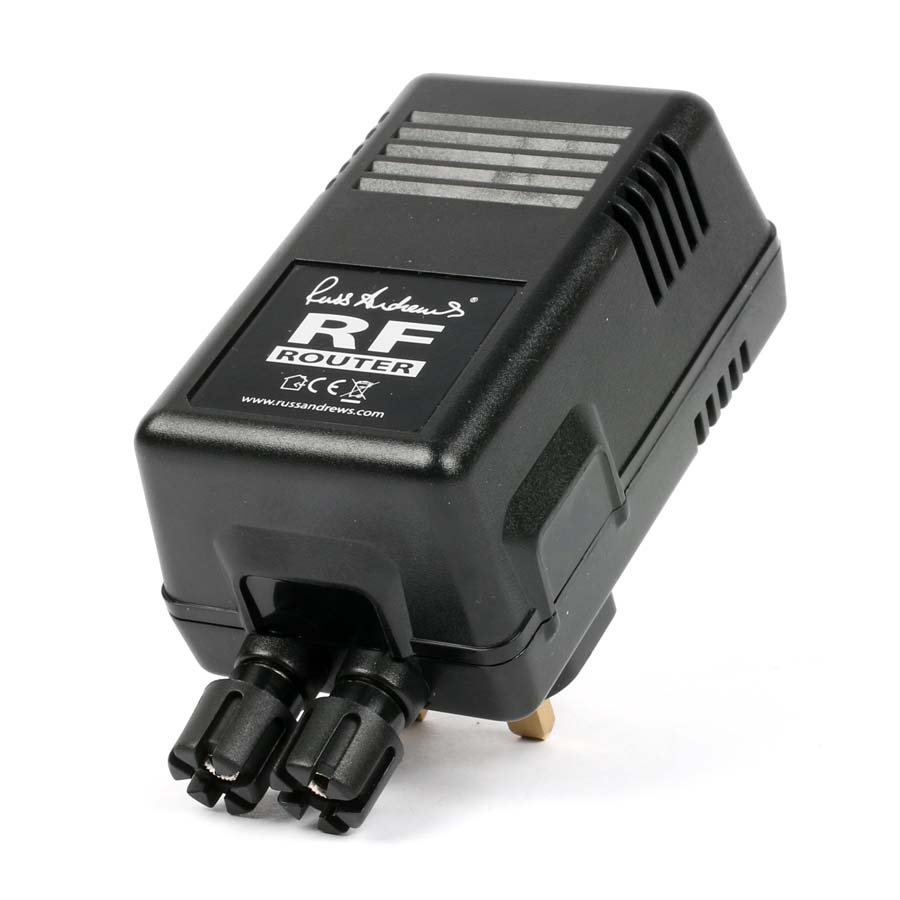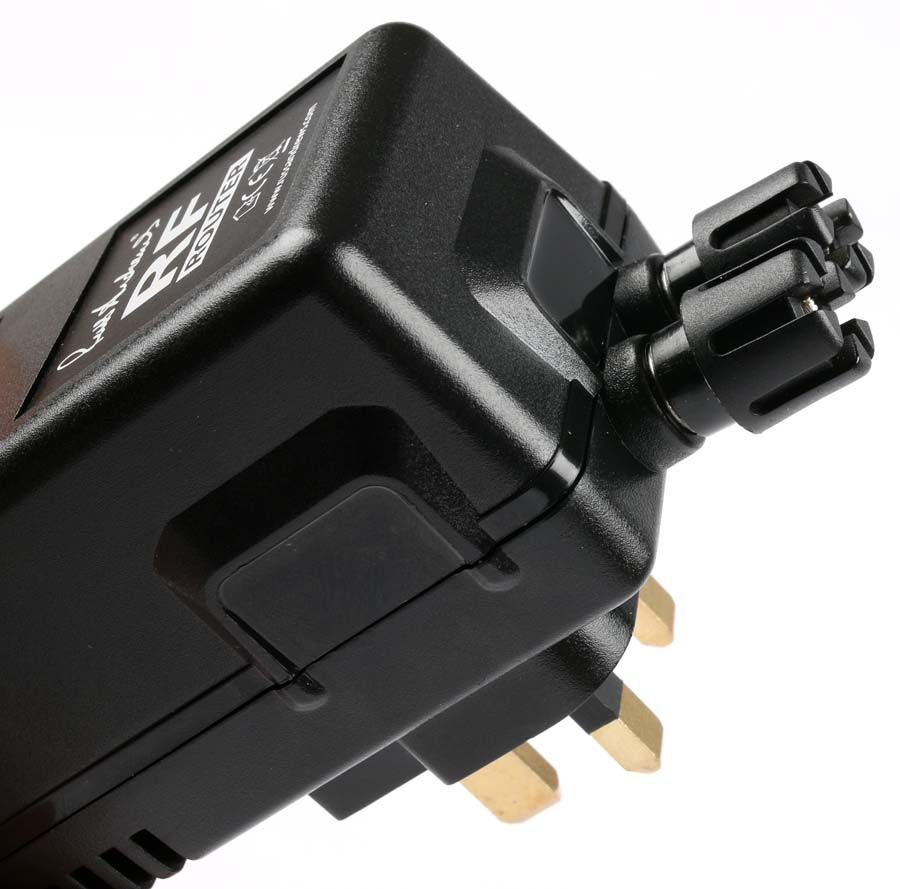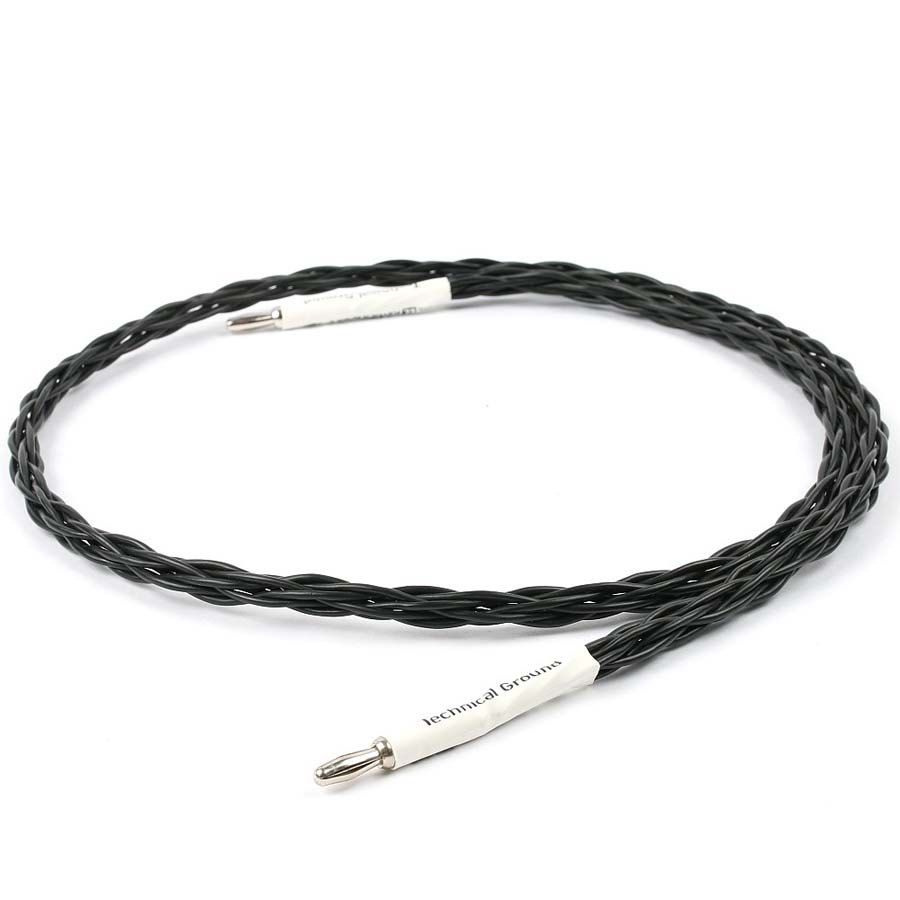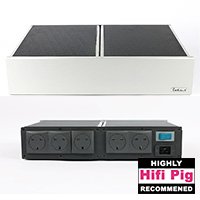RUSS ANDREWS X6 MAINS BLOCK AND PLUG-IN RF ROUTER
Russ Andrews X6 Mains Block and plug-in RF Router is the popular brand’s latest product for power distribution with added RF Routing. Janine Elliot takes a listen to this £785 pairing.

When I was sent a 3.5m pair of Kimber Kable 4PR and 8PR speaker cables for review (see review), supplied inside a fairly small box, I also managed to extract – like a magician out of a top hat – a 6-way X6 Block extension block (£520), a plug-in RF Router (£265) to kill high-frequency interference, plus 6 Yellow power 1m IEC leads, a 2m Evolution 300 PK mains cable for the X6 and a 2m grounding weave cable with banana plugs at each end to connect from the X Block grounding terminal to the RF Router. Alas, I didn’t find a rabbit. I am very familiar with Russ Andrews’ mains conditioners and extension leads, having reviewed several, but the RF Router would be a new technology for me to play with.
Russ Andrews is a familiar name in the world of HiFi ancillary equipment, starting out in HiFi retail in the late 1960s and by the mid-1970s and having his own HiFi shop (Russ Andrews Hi-Fidelity) in Edinburgh. During this time, he came to the conclusion that all was not well in the HiFi industry and so starting his investigation into mains quality, cabling and bits and bobs to make your HiFi sound its best, culminating in the formation of a company with his name in 1986, beautifully placed in Kendal, Cumbria. Since then, he has extended his portfolio to equipment and equipment modification, and acting as a consultant with several UK manufacturers on products including cartridges and loudspeakers. Having been one of the earliest to look into the effects of mains pollution in HiFi systems, he is now regarded by many as the one of the top experts in this field, and so confident is he about your satisfaction, his products are offered with a 60-day money back guarantee, and the X6 comes with a 25-year guarantee. Sweet.
BASIC RULES
Before looking at the mains blocks cables and RF routers, I decided to possibly correct a few thoughts on “earthing” and “grounding” as they are not the same thing. Indeed, the basic idea of “earthing” is quite simply a safety feature, so that if (God forbid) a live terminal of your HiFi component touches the chassis, all the current goes back to earth outside your house, rather than into you! You should always connect up your earth wire to the plug in the UK! “Grounding” is quite different. Grounding is a method – and this is important in my explanation of the Russ Andrews RF Router – of draining away any noise (Radio Frequency interference from lots of “sources” including phones, BT, Wi-Fi, radio, dimmer switches, hair dryers, etc, etc) that will attach itself to your equipment and cabling like a virus. Your HiFi will not work at its best if all this interference is there. I have always found anything to do with wiring can be a double edged sword; grounding everything is great – whether the chassis or spare signal sockets – but it has to be done sensibly, otherwise all the extra wires around your valued audio system can accumulate even more RFI or EMI, plus it can look rather more unsightly than the spaghetti junction of speaker/RCA/XLR cabling already does. So, this review was always going to be grounded in problems for me!
WHY DO YOU NEED A GOOD POWER BLOCK FOR YOUR HiFi?
Sceptics still wonder why we would ever need a serious mains strip. After all, surely it a basic mains strip can’t make things worse than what is already coming into your house? Alas, from experience, a basic power block from your local DIY store will introduce more noise into your HiFI system and can turn your music into a harsh metallic bright sound. It will also be badly made in terms of build and parts. The X6 Block ‘blocks’ this from happening, and, the extra grounding-link at one end to connect to the RF Router reduces EMI’s and RFI’s that float around your living room and kitchen. Russ has been selling mains blocks for many years using excellent quality components that ensure good connections to your mains supply. Whilst some might think that using extension leads to connect all your HiFi together in one place is a bad thing, degrading quality and performance, the opposite is true (I believe) as a single point for connecting all your components (known as “star powering”) is the better option, as well as looking neater, of course!

FEATURES AND SPECIFICATIONS OF THE RUSS ANDREWS X6 BLOCK AND RF ROUTER
The new X Block mkii series comes in various sizes, including 2, 4 and 6-socket IEC and EURO options (as of this review the 8-way X8 doesn’t yet have the extra grounding link on the side), plus the more expensive X8 Power Block Professional and finally the X8 Power Block Perfectionist coming in at £2,251. The X6, up for review here, comes in at only £520, which is excellent value compared with some similar devices.
The X6 is a superbly built unit, made in the UK using RA’s excellent Ultra Sockets™, all Deep Cryogenically treated and with DeoxIT® contact enhancer. Internally, the units are connected with TCX™ copper Kimber Kable (Russ was first introduced to American Ray Kimber in 1986). The block is fitted with their Silencer™ mains filter to reduce mains noise interference, plus a SuperClamp™ with spike and surge protection. An addition in this mkii variant is the all-important Ground Terminal to connect to the ‘passive inductor-less’ RF Router, or to an external grounding rod. It also has a 10A IEC output so that you can daisy-chain it to a second block if you have a lot of gear. The casework is made from shatterproof ABS, not only because of its fire resistance, strength and rigidity, but because of its acoustic neutrality. It also obviously keeps the price down. Only the Super Clamp requires maintenance, with Russ recommending a factory replacement of all components every five years.
The RF Router comes in two guises; one that connects to your mains supply, and an identically priced unit (RF Router Mk2) that you connect to a grounding spike (£25) that you can submerge into your garden, unless of course you live on the 10th floor of a block of flats. Both have two input sockets, which means four connections are possible if you use both a banana and spade on each terminal. The wall-wart RF Router is a passive unit that only connects to the earth socket so you don’t even need to switch on that mains socket. The other two pins on the 13A plug are simply there so that the box stays in place in the wall socket! It was at this point that I had thoughts on how the unit could possibly work with the X6 which also has its own untreated earth connection, and that is also where the words earthing and grounding needed to be fully understood. After all, the RF Router is connected to the grounding socket on the X6 and thence to the “earth” socket at your mains, and the X6 Block itself is also connected to the earth socket of the very same mains. Do the two mix? Time to switch on my brain before my HiFi, and perhaps also ring up Russ Andrews! What I discovered was not what I initially thought would happen. The idea of the RF router is not to actually clean the earth as it comes in but to dump all the dirty stuff that’s already on your HiFi back into the wall socket; the term “router” is fine but just confused me a tad. Perhaps “RF Reverser”, “RF Drain” or “RF Dumper” would be better terms. If the Router had worked like a filter the X6, even with all its built-in gubbins would still have let more through. So, OK, the RF Router takes all the interference on your HiFi chassis and XBlock back to the earth socket, and hopefully it won’t work its way back into the X6 block that’s connected on the next 13A earth socket! The best option, then, would probably be the grounding spike connected in your (preferably British wet) soil in the garden. If only we could all do that. Rather than come to a conclusion that this pluggery simply might not effectively work, I decided to do a (long) test to see just what actually happens, and I have to admit my initial simple untrained conclusion was unfounded. This isn’t magic but clever thinking! The idea for these routers came from a conversation with the audio designer Ben Duncan after a change in UK wiring regulations in 2008 which states that you cannot simply connect your house ring earth to an outside spike. Ben came up with a way around this which then led to the RFI dumping circuit designs, which also now include the more expensive SuperRouter and Signature Edition which both have 12 grounding sockets.

SET UP
Putting it all together couldn’t be simpler and the use of cables and units from the same manufacturer always works well and looks good, too. I set up my valve KT88 Synthesis mono-blocks with my sources and speakers as close to RFI/EMI emitting objects in my house as possible! Of course, I positioned it so that I could gain excellent listening of music, because as well as interference reduction, I also wanted to see if the use of the RA equipment would make my kit sound any better! After all, if the high-frequency interference didn’t degrade the music there would be no purpose in spending the money on these devices in the first place. Much as I wanted to take the equipment apart and look inside, the X6 need special tools to undo the hexagonal connectors and the RF wall wart is near impossible to break into! Better use my ears and not my eyes and fingers. Now, as my equipment contains both RCA and XLR balanced pluggery it is important to fully understand how earthing and grounding are linked. RCA plugs just have two terminals; signal and ground, commonly known as positive and negative as you need the two to make it all work. The ground usually connects to the “earth” chassis and earth wire to the mains socket. Balanced connectors have the positive and negative, with the third pin being the signal ground. So, connecting my HiFi compounded my confusion even further! Using balanced components from source to preamp to power-amp certainly makes my HiFi work better; greater bass depth, more articulate, etc. For my test, not only did I connect the RF Router to the X6 using the £80 2m Kimber Technical Ground Weave cable with its 8 woven conductors (remember to connect it the right way round!) but also used some of my own simpler but good quality wire to ground the equipment being used to a single grounding post and thence to one of the two sockets on the RF Router. Don’t daisy- or multi-chain from one piece of equipment to the next as that creates a grounding loop and acts like an antenna and makes even more noise and interference! As there isn’t just one simple way that everybody connects up their HiFi (after all, we have different equipment and therefore might have a myriad of ways of fitting it all together), it’s probably actually a good idea to give RA a phone call, ’cause they are very friendly people and with all their experience can suggest the best way you should be using your block and router.
SOUND QUALITY OF THE X6 BLOCK ii AND PLUG-IN RF ROUTER
My first tunes were Elton John’s 1973 “Funeral for a Friend”. With RA in control, the music seemed tidier, especially in the bass and quicker on top; with the percussion bass thumps at the start of the second section of the music sounding clearer and with greater dynamics, and then a more controlled and clearer vocal third section, culminating in better 3D soundstage in the piano solo scales/broken chords in the fourth. I love this work as it has so many ideas/sections connected together in one “piece”, just as another favourite – Queen’s “Bohemian Rhapsody” – did the same idea 2 years later, though even better. The improvements from the Russ Andrews products was noticeable after a few seconds, but seemed to get even better the longer I was playing.
Most will love Rachmaninov’s music; indeed, many pop singers in the past have stolen some of his best ideas such as Eric Carmen’s “All By Myself” (Piano Concerto No 2, 2nd movement), just as Barry Manilow’s grave-robbing of Chopin’s Prelude in C minor in his “Could this be Magic”. But lesser-known romantic composer Nikolai Medtner, who was a close friend of Rachmaninov, also stole a lot of his ideas and his composing “style”. As a university student I was lucky enough to be taught piano by a lady who “housed” Medtner after he came to England from Russia (in 1936) just before he died in 1951, so I have, love and play some of his original piano music. Whilst not as good as his Russian comrade’s music, his Piano Quintet in C (1950, a year before he died) nevertheless has many ideas in it that could be from his idol, though in this particular recording (The New London Quintet with Malcolm Binns on piano) they’re not easy to make out, so wiring up the Russ Andrews equipment I decided to see if anything could possibly improve. As well as being a scratchy record at the start, the 5 instruments aren’t generally well spaced in front of me usually, but with the RF Router in place everything seemed to focus better, like going from a slightly “snowy” TV picture to perfectly focused image when your TV aerial is just in the right position – if any of you are old enough to remember those days. Any grit and interference seemed to disappear and even the soundstage improved, with better positioning of the instrumentalists with greater depth, only to be worsened when I unplugged the RF Router. The X6 mains block on its own is a great product and is very open and revealing compared to a basic block, but combined with the RF Router it subtly improved things to a point that you forgot this was just a scratchy record in my living room. There are other combinations of blocks and RF routers out there – like the Nordost QBase and QKore – but this one is very well-priced for the improvements you get and considerably cheaper than the Nordost! Whilst the Medtner LP is not a particularly engaging album, I felt compelled to listen with the increased detail and excitement on offer from the X6 and RF Router partnership. What is criminal is that Medtner recorded quite a lot of his great music for HMV when he was in Britain, but after he died none of his music was ever released.


Following on from this I decided to play an album from Jaco Pastorius. I consider him the best ever bass guitar player, especially as he transformed his guitar into a fretless bass, an idea that Bill Wyman, Rolling Stones, did many years before. His playing and his music is amazing, with the bass riff in “Come On, Come Over” in his 1976 debut album being one of the most learnt and played by students. I love his style of music – with influence of saxophonist Charlie Parker – but two years before all this he recorded a session at Criteria Studios, released in 2014 as “Modern American Music”, and I have to admit this 22-year-old’s music is not easy to digest after Sunday lunch; there is an awful lot going on in his fast-moving funk-influenced music with innovative use of harmonies, such as in his twelve-tone “Balloon Song”. With Alex Darqui on piano, Bobby Economou on drums and percussionist Don Alias, “Pans #1” has, yes, steel pans. Whilst a little more defined than the 12-tone number, it is still not easy to “take apart” the instruments in the fast-moving track, but as soon as I plugged in the RF Router suddenly space opened up and each pan and Fender Rhodes keyboard (Jaco playing) and drums just formed their own space in the music. Bass drum was easier to listen to and even more extended, and the awful semi-opaque red/black/brown splodge-looking vinyl record seemed OK to look at now. This album is not for the trad-jazz fan, and certainly not for those of a nervous disposition or with a headache, but the added RF medication seemed to act as a Paracetamol and anti-depressant in one go. It’s sad that whilst being one of the most influential and brilliant bass guitarists (even playing with Pat Metheny and Joni Mitchell), after a life of drug addiction, mental breakdowns and financial difficulties, Jaco died of injuries following a being beaten up outside a Florida night club. He was as confused as his music.
A little easier on the ears was Muse ‘Drones’ album. Whilst still very fast-moving music, it was more toe-tap-inducing. Like the Jaco, there are a lot of ideas in this music which can also sound bright and “gritty” on the top, especially when using my Wilson Benesch’s and Townshend Supertweeters. “Reapers” just sounded remarkably clear, and almost muz-ical with the RA duo. Having stuck grounding cables in every orifice I could find, “The Handler” really handled things well with clear detail in the top and bass surprisingly extended on the usually bass-light Arc speakers. I had never heard things this clearly lower down on these speakers, so a quick move to Widor’s ‘Symphony No 5’ was inevitable. This symphony is actually just for organ (which I guess is really a complete symphony orchestra in its own right) and is best known for the “Toccata” 5th movement. This Hyperion LP has David Hill playing the excellent organ of Westminster Cathedral, London (Wills and Sons, 1922-32). If only they could magically squeeze that last movement at the end of the side 1 of the LP! With the X6 and RF Router connected the Toccata was nothing short of amazing on the WB’s – frequency extended, controlled, clean, exciting, mystic in the quiet sections and magnificent when the organ blew as loud as it possibly could. Surprisingly, having gone through Prestorius, Muse and Widor all in one go I hadn’t suffered any fatigue, nor did any of the music sound stressed or gritty. The transparency and musicality from having none of the electrical interference just made my equipment sound at its best. All I needed now was a balanced mains unit (yes, and Russ Andrews does those as well).


Finally, I needed to play some music that had lots of space and timing to see what the £800 duo could muster in my EMI/RFI-infested house, eking out the purity from the non-infected mains supply. Firstly, Katie Melua’s recent ‘Love and Money’ album supplied me with micro-details at the top, especially with the acoustic guitar, some amazing bass detail in “Reefs”, and effortless vocals throughout but especially in the last track. Pink Floyd’s ‘Dark Side of the Moon’ was the obvious choice for my last listening session. From the crescendo heartbeats at the start to the full-on prog rock, the performance was notably improved; greater dynamics, excellent 3D soundstage, extra information that could be heard and more hi-frequencies on the vocals (but not gritty). Unplugging the RF Router and the top detail just vanishes, and initial transients sound slower. I’d still like to call this all magic, but actually, I think the team at RA really know more about the reality of our mains than I ever will.
CONCLUSION
£520 + £265 + £80 + mains leads isn’t actually a lot of money to pay out for a way of controlling the mains interference that infests our HiFi, especially since if you find it doesn’t work in your system you can simply return it all within 60 days to get your money back.
This bundle of goodies was a no-brainer for me; the difference in sound, particularly the detail of bass, soundstage and top-end focus was so noticeable to me, even with my initial scepticism. The music was noticeably less edgy and metallic.
If you can afford another £25 and get an earth rod to bury into your garden soil with the RF Router mkii, then that would be the best option, but whatever you decide it could be the cheapest upgrade to your existing HiFi. Now, I wonder if Russ would notice if I don’t put these items back in that cardboard box that arrived with the Kimber Kables….
AT A GLANCE
Build Quality:
All well-made, especially the X6 Block mains sockets
Sound Quality:
Noticeable improvement in top frequency detail, bass extension and transparency.
Value For Money:
At £520 for the X6 Block + £265 for RF Router + £80 for Kimber Technical Ground Weave (2m) this is not a lot of money to improve upon the quality of mains in your system and removal of RF interference. Whether a lower or hi-end system, it will work just as effectively
We Loved:
Focus and transparency of the music
Tidier and extended Bass
Increased dynamic intensity of the music
Improved 3D soundstage
We Didn’t Love So Much:
Means more wiring, especially if you ground all your components!
Elevator Pitch Review: I was rather sceptical at first, thinking ‘surely this can’t work, or at least not much’, but of course as a reviewer one cannot write a conclusion until the end of trying it out first. I was in for a big surprise and it got me more and more concerned about the effects of high-frequency interference that comes into our homes caused by our 21st century lifestyles of using wifi, BT, phones, etc. Whilst mains conditioners (or better still, balanced mains units) can improve what comes in from outside – and the X Block series includes their Silencer mains filter to reduce mains noise interference, plus a Super Clamp surge protection – the RF Router works to eradicate the high-frequency interference, sending it back to your mains earth, or better still an earth rod in your garden. Just how effective would this duo be? I was quite surprised just how good, and better the longer it was all connected.
Price: X6 Block ii £520, RF Router £265

Janine Elliot
System used:
Pre-Audio GL-1102N/Ortofon Kontrapunkt b (linear-tracking turntable/cartridge); Manley Steelhead (phono-stage and analogue preamp section); Krell KPS20i (CD); Ferrograph Logic7 (reel to reel); Synthesis Roma 98DC valve (amplification); Wilson Benesch Arc plus Townshend Supertweeter (speakers); Tellurium Ultra Silver 2 and Townshend F1 cables, Coppice Audio stand and Townshend rack.
SUPPLIED SPECIFICATION
X Block mains extension;
high-performance audio-grade mains extension
NEW Ground terminal & 10A IEC mains output socket
Features Russ Andrews UltraSockets™ treated with DCT and DeoxIT®
Internally wired with Kimber Kable® TCX™ cable
Incorporates Russ Andrews Silencer™ mains filter and SuperClamp™ for mains noise reduction
RF Router;
Passive unit
Simple plug-in solution to connect your casework to ground
Selective RF Filter technology
High-quality, nickel-plated binding posts
Merit-Based Reviews and Awards
At HiFi PiG, our reviews and awards are always free. No fees for reviews, no fees for the recognition we give.



















































































































































































